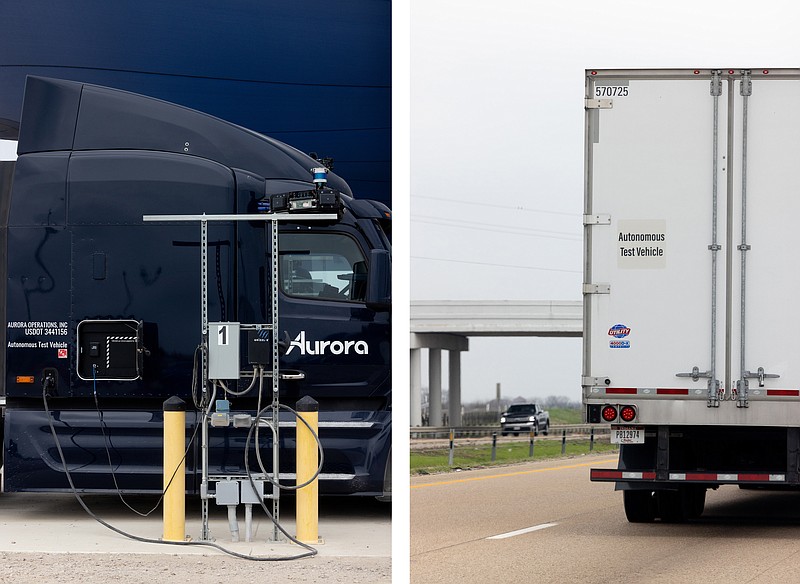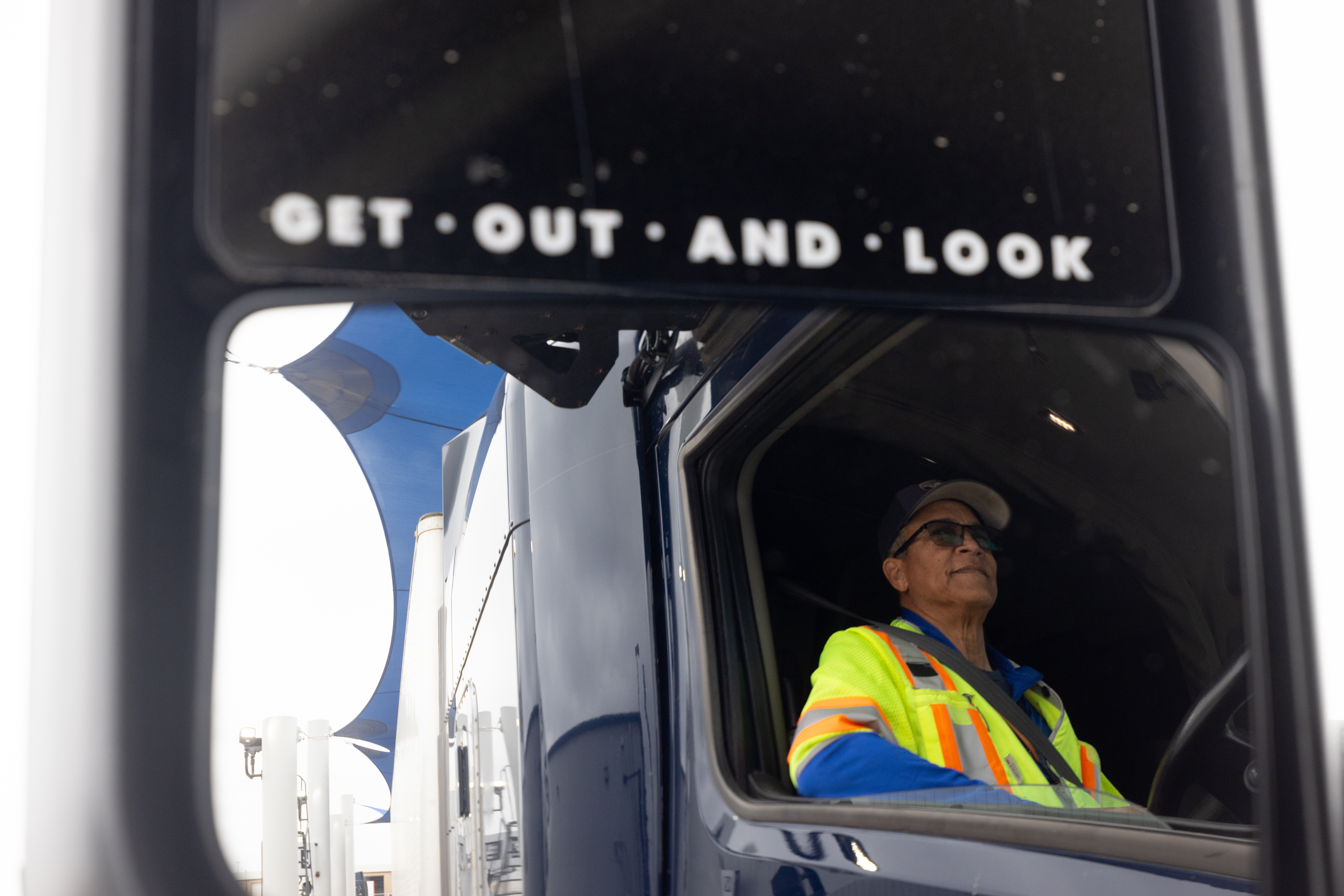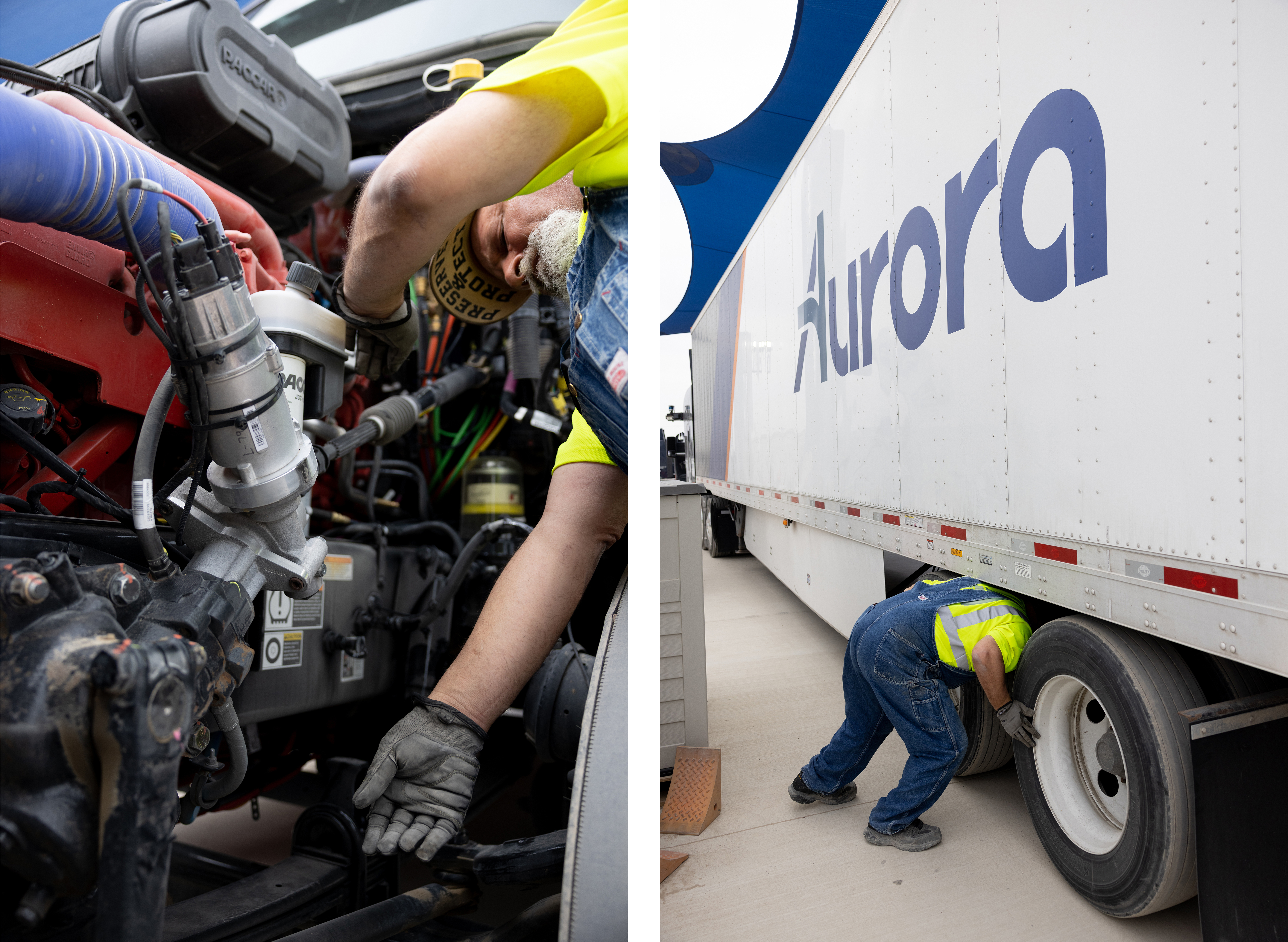PALMER, Tex. - Perched in the cab of a 35,000-pound semi-truck lumbering south on Interstate 45, AJ Jenkins watched the road while the big rig's steering wheel slid through his hands. Jenkins was in the driver's seat, but he wasn't driving. The gigantic 18-wheeler was guiding itself.
Over several miles on the popular trucking route between Dallas and Houston, the truck navigated tire debris, maneuvered around a raggedy-looking flatbed and slowed for an emergency vehicle. Exiting the highway, it came to an abrupt stop as a pickup jumped its turn at a four-way intersection.
"You need to be ready for anything," said Jenkins, 64, a former FedEx driver whose job is to take control if anything goes wrong. "People do some crazy stuff around trucks."
Operated by Aurora Innovation, the truck is part of a new class of autonomous big rigs plying the nation's highways. By the end of this year, the trucks will for the first time start traveling alone, without human minders like Jenkins, as two major companies - Aurora and Kodiak Robotics - launch fully autonomous trucks in Texas.
The advent of robot trucks could have a massive impact on America's supply chain, dramatically reducing the time it takes to transport goods from place to place and unbinding the trucking industry from the costs and physical limitations of human labor. But the technology's advancement has sparked concerns about highway safety, job loss, a lack of federal regulation and a patchwork of state laws regarding where and how autonomous trucks can operate.
By default, driverless passenger vehicles and trucks can ride anywhere in the United States, unless a state explicitly says they can't. That means companies can test and operate their vehicles across most of the country. Two dozen states, including Texas, Florida, Arizona and Nevada, specifically allow driverless operations, according to data compiled by Aurora, while another 16 states have no regulations specific to autonomous vehicles. The remaining 10 - including California, Massachusetts and New York - place limits on autonomous vehicles within their borders.
Alarmed by the slow pace of federal regulation, labor and safety advocates are pushing legislation in several states to ban driverless trucks outright. So far, the effort has been unsuccessful. The California legislature approved a measure last year that would have required human operators in all autonomous trucks, but Gov. Gavin Newsom (D) vetoed it, calling it "unnecessary" in light of state regulations that already ban autonomous vehicles over 10,000 pounds.
Transportation experts have been frustrated at how slowly the federal government has moved on the issue, given its potential to disrupt a massive part of the American economy.
Steve Viscelli, a sociologist at the University of Pennsylvania who studies the trucking industry, said autonomous trucking could "change the geography of our economy in the way that railroads and shipping did."
"There are real concerns that drivers have of the impacts of this," Viscelli said, "and we need to take them seriously."
Driverless passenger cars have caused chaos in cities like San Francisco, including one horrific accident last year when a robotaxi hit a jaywalking pedestrian and dragged her about 20 feet. The potential for catastrophe is even greater with massive autonomous trucks, critics say.
"Even with these small vehicles, it has been a disaster," said Peter Finn, a vice president of the Teamsters Local Union 856, which represents truck drivers. "The notion that there is going to be no human being in large trucks barreling down the highways absolutely frightens me."
- - -
Major expansion
Today, Aurora's long-haul trucks are transporting packages and produce - about 100 deliveries a week - for FedEx, Uber Freight and others. Founded in 2017 by former executives at Uber, Google's self-driving project and Tesla, the company has been training its driverless trucks in Texassince 2020.
By the end of this year, Aurora says it plans to have about 20 fully autonomous trucks working the 240-mile stretch between Dallas and Houston. Eventually, it plans to operate thousands of trucks all across America.
Kodiak Robotics, which was founded by a former employee of Uber and Alphabet's Waymo, similarly plans to launch a fleet of trucksby the end of the year in Texas. A third company, Daimler Trucks - a subsidiary of German-owned Daimler that has partnered with Torc Robotics - is a few years behind, with plans to launch a driverless fleet in America by 2027.
Nat Beuse, Aurora's chief safety officer, said the self-driving truck industry has been "methodical" in deploying its technology, adopting strict safety standards, including how the trucks respond to various system failures. Beuse said the company has learned from the mistakes of other autonomous vehicle companies, including General Motors-owned Cruise, which recalled its entire driverless fleet after the San Francisco crash.
"The federal government has been clear in that unless a state says you can't deploy, you can. But that doesn't mean as a company we don't have responsibilities," Beuse said. "This is not a science experiment."
Marc Williams, executive director of the Texas Department of Transportation, said Texas has a good relationship with the companies testing on its roads. The state has been atthe "forefront" of supporting the industry, he said, and it is critical for its economic growth as demand grows for moving freight around the state.
"If we're going to meet that challenge, it requires us to be successful in these partnership and collaborations with trucking and autonomous trucking industry," Williams said at a February panel with Partners for Automated Vehicle Education, a coalition of industry advocates.
The average driver would find it tough to spot one of Aurora's trucks, which bear only a small rear-facing sign that reads "AUTONOMOUS TEST VEHICLE."
The view from inside the cab looks very different, however. On a recent day in February, two computer screens animated a flurry of potential hazards: Tire debris dotting the shoulder. Impatient SUVs and sedans eager to pass. An SUV merging without a turn signal.
Stephen Tune, a vehicle operations specialist, sat in the passenger seat, monitoring the screens. He narrated the truck's every movement for Jenkins: "Moving to the right to avoid tire debris," Tune saidas the turn signal began to blink. "Moving to the left as a courtesy to the car behind us."
On this drive, the truck followed all the rules of the road and even demonstrated an uncommon courtesy to other drivers. But it's the unexpected scenarios - from errors by human drivers to sudden mechanical issues - that worry veteran truck drivers like Lewie Pugh.
"I know my computer and cellphone make mistakes. Machines can have bad days, too," said Pugh, executive vice president of the Owner-Operator Independent Drivers Association, a national organization representing professional truck drivers.
While Texas has been the center of autonomous truck testing, companies also have been running vehicles in Oklahoma and New Mexico, among other places. Since 2021, trucks operated by all three majorcompanies have been involved in a handful of traffic incidents, according to data from the National Highway Traffic Safety Administration (NHTSA).
None have been fatal or caused serious injuries, but the incident logs provide a window into the range of obstacles the trucks have faced.
In July 2022, a Daimler truck rolled over an object on a New Mexico highway that punctured its fuel tank, causing oil to spill onto the highway. In December 2023, a deer stumbled onto the path of a Daimler truck testing in Texas. The test driver took over, but the truck still hit the deer.
Earlier that month, a pickup truck trying to overtake an Aurora vehicle hydroplaned and hit the Aurora's trailer. The Aurora detected the pickup but was unable to avoid contact.
The companies will be attempting to succeed in an industry that has faced setbacks. Waymo, the self-driving company owned by Alphabet, said in July that it would push back the timeline of its trucking efforts so it could instead focus on ride-hailing. Chinese autonomous trucking company TuSimple Holdings wound down its U.S. operations in 2023, a year after one of its automated trucks was involved in a crash while testing.
Still, autonomous trucks will make highways safer, those working on the technology say. According to the latest federal data, 5,788 people were killed in crashes involving a large truck in 2021, representing 13 percent of traffic deaths that year.
- - -
Tech moving faster than regulation
As profit-driven companies race toward deployment, the federal government has been slow to grapple with the implications of the new technology. The U.S. Transportation Department has largely allowed the companies to test their products on public roads, as long as companies comply with the same safety standards that apply to traditional human-driven trucks.
Within the Transportation Department, NHTSA and the Federal Motor Carrier Safety Administration have been working for more than five years on a proposal to create basic "safety guardrails" for autonomous trucks, including requirements for remote assistants to monitor the driverless vehicles, inspections and vehicle maintenance. The proposed rule, which was submitted to the White House's Office of Management and Budget in December, would be the Biden administration's most significant action on autonomous trucking.
Transportation Department spokesperson Sean Manning was unable to say when the rule might be finalized, as it still has to go through several more bureaucratic steps. Until then,Manning said existing laws prohibit any vehicle, including those equipped with automated technology, from "posing an unreasonable risk to safety." Meanwhile, NHTSA "will continue its vigorous enforcement using its defect and oversight authorities," Manning said - including investigations or recalls - if it finds evidence of risk.
Aurora and Kodiak both support the idea of federal regulation, which would give them more certainty about standards as they expand nationally.
"Having a federal framework gives confidence to regulators and the public that the federal government is watching this closely," said Daniel Goff, the head of policy at Kodiak.
- - -
Anxious truck drivers
Richard Gaskill, a truck driver in Texas since 1988, said he spots an autonomous test vehicle every now and then as he carries loads along I45.
"It's too new for me to trust," Gaskill, 50, said of the technology. "I don't like the idea of these being out there taking our jobs."
Gaskill's anxiety is shared by union and trade groups like the Teamsters.But a 2021 study from the Transportation Department suggests concerns about widespread job loss may be misplaced: Autonomous trucking could at most lead to 11,000 layoffs in the next five years, the study says - less than 2 percent of the long-haul driver workforce.
Meanwhile, the study notes that the technology could create new job opportunities for maintenance technicians, dispatchers and fuelers while helping to relieve the drudgery that sometimes comes with being a long-haul trucker. And the autonomous truck companies say their technology can help transport goods around the country faster, as robot trucks can drive longer hours than human drivers.
Gaskill doesn't buy it. He says he can't fathom how a robot could navigate the nation's chaotic highways better than he can. But as companies like Aurora expand, he is resigned to the fact that autonomous trucks are part of the future.
"It's just a matter of time," he said.




